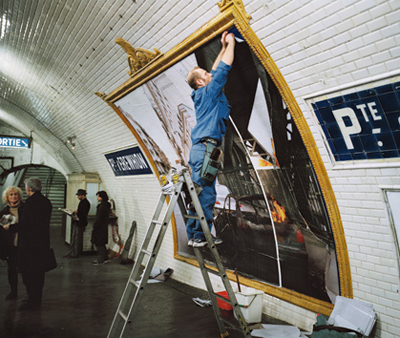

Film stills courtesy of Eric Baudelaire
In the first half of the 20th century, French philosopher Henri Bergson described duration as an invisible process, like sugar dissolving in a glass of water. Using this reference as a jumping-off point, the Paris-based artist Eric Baudelaire has created the film Sugar Water, which is presented at the Hammer Museum in Los Angeles for the artist’s first U.S. solo museum show.
The film takes place on the fictional Paris metro platform at the fictional Porte d’Erewhon, where a billposter descends into the station to cover a large advertising billboard painted bright blue. He continues to wheat-paste a sequence of images that depict a common car parked on an anonymous Parisian street. He continues by then covering that image with one of the same car busting into flames. The billposter continues until the car becomes swallowed up in smoke, and then remains only as a burnt-out skeleton of the former car. All the while, metro riders enter and exit the scene seemingly oblivious to the slow-motion narrative action taking place. Baudelaire hired a real billposter to lay down the imagery, but the commuters who move in and out of the station are all hired actors, enacting a sort of role reversal in which the person upon whom the single camera focuses is not an actor; the “extras” who fill the background, meanwhile, are. Eventually, this cinematic event unfolds over the seventy-two-minute film, creating a slow reflection on images we typically experience in our news media.




 Facebook
Facebook Permalink
Permalink Digg
Digg Reddit
Reddit LinkedIn
LinkedIn StumbleUpon
StumbleUpon Tumblr
Tumblr

